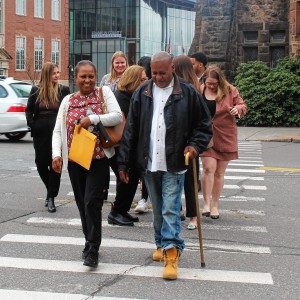My Turn: Killing coyotes is no answer — we must learn to live with them
| Published: 04-03-2023 3:22 PM |
City dwellers take many forms. In Boston and cities across Massachusetts, hundreds of different species call our cities home, including foxes, raccoons, bald eagles and coyotes.
It’s surprising for most urban dwellers to learn that species such as coyotes not only live in urban environments but thrive. Urban environments serve as ecosystems for a wide variety of life, and significant conservation efforts over the last few years have been made to rewild human-dominated landscapes to a more natural state, including Boston.
These conservation efforts are becoming increasingly important in the face of biodiversity collapse, and provide more green space for urban residents and wildlife alike.
Although surprising, the presence of coyotes shouldn’t be feared but welcomed. Fearmongering headlines and misinformation, unfortunately, depict coyote presence as a threat, but these stories dramatically overstate the exceptionally rare instances of conflict and fail to provide important information on how to effectively coexist with coyotes.
In truth, coyotes live among us in every state and city in America (except Hawaii). They are not a vicious predator but an unassuming neighbor who rarely comes into conflict with humans.
Moreover, inaccurate fearmongering can lead to alarming and unethical lethal responses in places like Nahant.
Despite what town officials claim, killing coyotes will not prevent risk. The sources of risk are the attractants that humans leave out, including the open community compost pile that will continually habituate coyotes if not remediated. There are also local instances of humans actively feeding coyotes, exemplified in a video a local resident shared with us showing coyotes being fed from a vehicle.
This type of human behavior creates conflicts with coyotes. The town of Nahant’s decision to hire sharpshooters to kill coyotes accomplishes nothing when the source of the problem, human feeding, isn’t addressed.
Article continues after...
Yesterday's Most Read Articles
 Greenfield homicide victim to be memorialized in Pittsfield
Greenfield homicide victim to be memorialized in Pittsfield
 1989 homicide victim found in Warwick ID’d through genetic testing, but some mysteries remain
1989 homicide victim found in Warwick ID’d through genetic testing, but some mysteries remain
 As I See It: Between Israel and Palestine: Which side should we be on, and why?
As I See It: Between Israel and Palestine: Which side should we be on, and why?
 Softball: Greenfield puts up 9-spot in the 8th inning to knock off rival Turners 11-2 in extra-inning thriller (PHOTOS)
Softball: Greenfield puts up 9-spot in the 8th inning to knock off rival Turners 11-2 in extra-inning thriller (PHOTOS)
 DA to announce breakthrough in 1989 unsolved homicide in Warwick
DA to announce breakthrough in 1989 unsolved homicide in Warwick
 Former Greenfield man granted new trial after 1995 murder conviction, walks free
Former Greenfield man granted new trial after 1995 murder conviction, walks free
As of today, Nahant has spent $9,000 to kill one coyote and they just re-upped their contract for a year. They are the first Massachusetts community to pursue this deadly strategy, which will soon prove ineffective. They will kill coyotes using more taxpayer dollars, more coyotes will fill those vacant territories and become habituated, and then they will repeat the vicious kill cycle again.
As humans continue to take up more space and resources in this increasingly crowded world, it’s imperative we learn to coexist with all creatures. Coyotes are Massachusetts residents and serve a crucial role in our ecosystems by controlling rodent populations and tick-borne diseases such as Lyme disease.
They’ve also become exceptionally savvy at learning to adapt to human presence by becoming more active at night to avoid humans and traveling solitarily instead of in packs to more easily move through urban environments.
Coyotes are doing the hard work at learning to co-adapt to human presence. What they deserve from us is at least equal effort. Luckily a few simple strategies are proven to keep coyotes, companion animals and people safe.
First, do not feed coyotes. Feeding coyotes habituates them to human presence and teaches them to associate humans with food. Feeding ordinances in cities are exceptionally effective and sometimes necessary to stop humans from feeding wildlife and creating unnecessary conflict. In just three to four weeks, after citing residents for feeding wildlife in Portsmouth, Rhode Island, coyote presence in a local neighborhood almost completely disappeared.
Second, haze coyotes that approach you. If a coyote comes too close for comfort, don’t panic, and simply direct bold and loud behavior at the coyote. Put your hands over your head, yell loudly, stomp your feet; this type of human response is typically more than enough to scare away a coyote. Remember, coyotes are naturally wary of human presence so any loud behavior directed at them keeps them wild.
Third, walk your dog on a leash, especially during the months of April to July. Coyotes are raising pups in dens during this time and the presence of dogs near den sites puts extra stress on protective coyote parents. Also, keep your cats indoors. It not only keeps cats safe but ensures coyotes don’t mistake them for potential prey.
Lastly, appreciate and observe the adaptability and perseverance of these animals in the most challenging of environments. Coyotes are finding a way to live among us, adapting their behavior, changing their diet, and raising their families in the same green spaces in which we raise our families. We live in a shared, diverse, and beautiful world with space for all of us.
Renee Seacor is the carnivore conservation advocate for Project Coyote and The Rewilding Institute, where she works to foster coexistence between people and wildlife. John Maguranis is the Massachusetts representative of Project Coyote and a retired animal control officer from Belmont.

 Guest columnist Gene Stamell: We know what we know
Guest columnist Gene Stamell: We know what we know Michelle Caruso: Questions candidate’s judgment after 1980s police training incident
Michelle Caruso: Questions candidate’s judgment after 1980s police training incident Kathy Sylvester: Vote for expertise on May 6
Kathy Sylvester: Vote for expertise on May 6 Shirley and Mike Majewski: Vote for Blake Gilmore
Shirley and Mike Majewski: Vote for Blake Gilmore
